

Suction Cups





A suction cup is a gripper which can be used to handle all sorts of objects of different weights, surfaces, shapes and sizes. For this reason we feel it would be helpful to explain all the parameters to be taken into consideration, in order to choose the right suction cup.
n Flat suction cups without cleats
Used for handling flat or slightly rounded, rigid, smooth objects. They withstand lateral forces and can be used for vertical handling.
n Flat suction cups with cleats

Used for handling thin, flexible, deformable objects. They increase resistance to lateral forces and horizontal handling.
The force of a suction cup is proportional to its surface under vacuum and also depends on its shape, flexibility, material and especially on the level of vacuum attained inside the suction cup.
Theoretical force
F(DaN) = S (cm2) x V (%) x 0,01013
S = Surface of the suction cup (cm2)
V = Vacuum level (%)
Actual force
As its name implies, this force represents the actual force of the suction cup when in use. In general this is 50% less than the calculated theoretical force.
This difference is explained by the distortion of the suction cup during handling (which reduces the gripping surface), and by the condition of the surface of the object being handled.
Diameters
The force of the suction cup and the product's available gripping surface depend on this parameter. COVAL offers standard suction cups of 1 to 600mm in diameter across the product ranges.

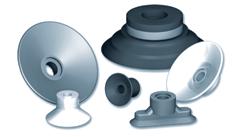
Minimum bend radius

This indicates the minimum radius of a product to be reliably gripped by the suction cup.
Used to handle spherical, cylindrical or egg-shaped objects. The effect of the technical characteristics increases with the number of bellows. They can be used for gripping objects with height differences, for a ball-joint effect, to lift and to grip corners or edges.
The safety factor
All holding forces are listed in the data tables for each range of suction cup. These are actual values at 65% vacuum, calculated with a safety factor of: n 2 for horizontal gripping (1), n 4 for vertical gripping (2).
For applications involving high acceleration, the safety factor will be calculated accordingly
Internal volume
This corresponds to the volume which must be evacuated during a vacuum cycle. It must accounted for in the total volume of the gripping system and thus in the suction time calculation.
Stroke
This corresponds to the compression of the suction cup during the vacuum cycle.

Shape of the load Flat • Rounded • Cylindrical • Egg-shaped • Spherical, etc.
Type of material of the load Porous • Porous • Deformable • Rigid • Fragile, etc.
Condition of the surface of the load Smooth• Granular • Ridged • Abrasive, etc
Appearance of the load Damp • Oily • Dusty • Viscous • Dry, etc
Weight of the load Heavy • Light, etc.
Temperature of the load From -40 to 250°C / -40 to 482°F depending on the materials chosen.
Direction of gripping Horizontal • Vertical • Over corners • Height differences, etc.

Type of grip Handling • Lifting • Holding • Unfolding … objects.
Available surface Depending on the load
Cycle time Accelerations
To meet the constraints of industrial applications, COVAL has a wide range of both standard and specific materials. COVAL can also study new materials based on specific requirements of your applications.

The COVAL laboratory has developed a new material: SITON®. SITON® is a siliconefree material which therefore does not leave a mark and was specially developed for handling hot objects that are waiting to be painted.
n SITON® can withstand a maximum temperature of 320°F / 160°C
n SITON® has good resistance to abrasion.
Example of an application: Removal of plastic parts from injection mold machine.
Standard availability in 60 shore and on request in 50 shore (Part No: STN5) for VSA and VS series.
Standard Configuration Options
COVAL suction cups offer versatile mounting and fitting options:
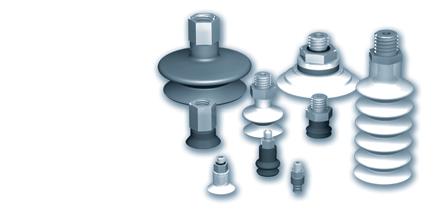
Version C: Barbed fittings.
The suction cup is easily pressed onto the fitting. The suction cups and their fittings are delivered unassembled.
Types of use:
n Lightweight products.
n Horizontal handling.
n For suction cups belonging to groups 1 and 2.
Advantages :
n Quickest changeout of suction cups without the need for tools, improving efficiency
n Fitting can be reused, thus reducing replacement costs.
Version V : 2-piece removable fittings (hollow screws and adapter)
The V mounting utilizes a hollow screw passing through the suction cup and connecting to an adaptor on the opposite side, fixing the suction cup in place. The suction cups and their fittings are delivered unassembled.
Types of use :
n Heavy and lightweight products.
n Horizontal, vertical and rotational handling.
n For suction cups belonging to groups 2 and 3.
Advantages :
n E xcellent mechanical grip of the suction cup.
n E xcellent vacuum sealing of the assembly.
n F itting can be reused, thus reducing replacement costs.
Version E : Pressed fitting (removable).
The fitting is factory pressed onto the suction cup.
Types of use :
n Lightweight and heavy products.
n Horizontal, vertical and rotational handling.
n Recommended for handling of porous products.
n For suction cups belonging to group 2.
Advantages :
n E xcellent mechanical grip of the suction cup.
n E xcellent vacuum sealing of the assembly.
n Greater potential vacuum flow rate when handling porous products.
Version S : Factory-crimped fitting
The fitting is factory-crimped onto the suction cup, ensuring a one-piece assembly.
Types of use :
n Heavy and lightweight products.
n Horizontal handling, vertical and rotational.
n Recommended for handling of porous products (when greater flow is required).

n For suction cups belonging to group 3.
Advantages :
n E xcellent mechanical grip of the suction cup.
n E xcellent vacuum sealing of the assembly.
n Greater potential vacuum flow rate when handling porous products.
Referencing
To simplify selection of fittings for standard suction cups, a male or female fitting option can be found in the example table, "Choice of fittings"
Ex :
Choice of Fittings
Standard configurations (suction cup + fitting)
Fitting: M = male F = female
Standard configurations (suction cup + fitting) now have a single part number, simplifying your stock managment and order fulfillment.
Ex:
Group 3 THREAD
To demonstrate assembly options, reference the example below, Standard configurations (suction cup + fitting) which indicates full part numbers as well as non-standard configurations
Non-standard mounting configurations
VSA78NBR VSA78NBRIM18VVSA78NBRIM14VVSA78NBRIF14VVSA78NBRIM14VSA78NBRIF14

VSA78NR VSA78NRIM18VVSA78NRIM14VVSA78NRIF14VVSA78NRIM14VSA78NRIF14
VSA78SIT5 VSA78SIT5IM18VVSA78SIT5IM14VVSA78SIT5IF14VVSA78SIT5IM14VSA78SIT5IF14
VSA78STN VSA78STNIM18VVSA78STNIM14VVSA78STNIF14VVSA78STNIM14VSA78STNIF14
Additional mounting configurations are available. You can find all options on pages "assembly diagrams"
Ex:
Removable fittings
Adapters
Hollow screws
Note :
For standard configurations (suction cup + fittings), the C and V versions are delivered unassembled.

78
Standard configurations (suction cup + fitting).
Non-standard configurations must be ordered in seperate part numbers.
Standard suction cups are suitable for all types of applications in various sectors like packaging, plastics, agri-food, sheet-metal working, etc.
See chapter 2
These suction cups satisfy very diverse specifications thanks to a wide range of shapes, diameters and materials. COVAL offers a full range of fittings adapted to suction cups and compatible with all types of applications.


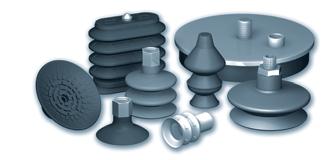

n Ø 8 to 75 mm
n 4 standard materials
n Extra-flat suction cups
n Ø 2 to 200 mm
n 3 standard materials
n Ø 6 to 50 mm
n 3 standard materials
n Flat suction cups with cleats

n Ø 15 to 50 mm
n 3 standard materials
n Flat oblong suction cuts
n From 2x4 mm to 30x90 mm
n 3 standard materials
Suction Cups with 1.5 Bellows
n Ø 5 to 78 mm
n 5 standard materials
n Ø 5 to 50 mm
n 3 standard materials
n Ø 10 to 150 mm
n 3 standard materials
n Ø 15 to 30 mm
n 2 standard materials
Suction Cups with 2.5 Bellows
n Ø 5 to 88 mm
n 4 standard materials
n Ø 5 and 7mm
n 3 standard materials
Long Stroke Suction Cups
n Suction cups with 4.5 and 5.5 bellows
n 2 standard materials
High-performance Suction Cups
n Full range of shapes (flat, bellows, oblongs)
n Ø 35 to 125mm and 25x65mm to 70x140mm
n 2 standard materials
n Integrated fittings
Suction Cups with Foam Rings
n Foam rings
n Can be adapted to standard suction cups
n 2 standard materials
n High tensile force and precise gripping and releasing
n High resistance to lateral forces allowing vertical handling
n Full range of fittings and shut-off valves
n Highly precise gripping and releasing of the load
n High throughput rates
n Suitable for gripping rigid and flat products
n Suitable for gripping rigid and flat products
n Cleats prevent the deformation of the product and provide excellent non-slip properties
n Used for handling elongated products such as pens, tubes, bottles, bulbs and flat or cylindrical objects etc.
n Combines the advantages of flat suction cups with added angle, flexibility and precision
n Used for gripping slightly concave or convex parts
n Full range of fittings
n Used for gripping slightly concave or convex parts
n Suitable for gripping products of various heights
n Recommended for gripping sensitive products due to the cushioning effect of the bellows


n Used for gripping slightly concave or convex parts
n Used for gripping slightly concave or convex parts
n Suitable for gripping products of various heights
n Recommended for gripping products on different planes (wide deflection) or cylindrical objects gripped at an angle (ball-joint effect).
n Full range of fittings
n Suitable for gripping small products, concave or convex

n Ideal for handling sensitive products
n Strongly recommended for handling spherical or cylindrical products requiring a large height adjustment.




n Textured suction cups for gripping thin sheets
n Non-slip cleats ensure optimum positioning of oily sheet metal
n Extreme resistance to slipping,
n Porous integrated fittings
n Ideal for automated applications
n Bonded under a suction cup to allow products with an irregular or even-ridged sur face to be gripped
n Sawn wood, sheet metal, flat sur faces with bumps or hollows (all types of granular surface)
Thanks to a technological mastery and collaboration with its customers in different branches, COVAL supplies solutions for vacuum handling via a wide range of special purpose suction cups.
E.g. handling eggs, flexible bags, raw composite, bottles, paper, cakes, etc.
Ultra-flat, Non-Marking Suction Cups
n Ultra-flat suction cups
n Ø 40 and 80 mm
n Materials : Polyurethane and silicone (FDA and CE standards)

FlowPack Suction Cups
n Flexible suction cups
n 4 models
n Food-safe materials
n Silicone: FDA and CE standard



n Suction cups with 1.5 and 2.5 bellows
n 9 models
n Silicone: FDA and CE standard
Suction Cups for Cheese
n Suction cup with 1.5 bellows
n Ø 50 mm
n Silicone: FDA and CE standard
n Oval suction cup with 1.5 bellows

n Dim. 65x150 mm
n Silicone: FDA and CE standard
Suction Cups for Bakery Applications

n Suction cups with 2.5 to 5.5 bellows
n 11 models
n Silicone: FDA and CE standard
Suction Cups for Egg-handling
n Suction cups with 2.5 and 3.5 bellows
n 3 models
n Silicone: FDA and CE standard 1935/2004
Suction Cups for Bottle Handling


n Suction cup system comprised of a 62mm cup with 2.5 bellows and a silicone gripping disc (COVAL-Flex).
n Suction cups with 4.5 bellows
n 3 models
n High tensile force
n Highly flexible and long stroke
See chapter 3
n Suction cups specially designed not to deform the product being handled.
n Vacuum distributed across the entire surface of the suction cup for an optimal gripping force.
n Extra-thin sealing lip designed to contour to the shape of the product being handled
n Range specially designed for gripping flexible packaging
n Thin and wavy lips mold per fectly to any shape of packaging
n Gripping ability allows for high production rates
n Used to grip delicate objects. Very flexible lip (opening bags, gripping tins and flexible aluminum or plastic bottles, etc.).
n High throughput rate
n Used to grip of flexible products
n Suction cup specially designed for gripping fragile foods such as soft cheese
n Accessor y: Stainless steel grill prevents deformation of the food
n Suction cup specially designed for gripping fragile foods such as soft cheese
n Accessor y: Stainless steel grill prevents deformation of the food
n Range specially developed for gripping delicate objects such as cakes (buns, biscuits, etc.)
n Specific shapes and shore A hardness depending on the applications
n Resistance to temperature: - 40 °C to + 220 °C
n Range specially designed to meet constraints involved when handling eggs.

n Very flexible lip
n Different shapes of suction cup
n The VBO suction cup system is designed for gripping bottles by the punt on disgorging stations.
n Excellent sealing when gripping different types of bottles.
n Used to grip 750 ml bottles and Magnums.
n Bottles gripped from the side, vertical and horizontal handling
n Suction cup with stainless steel reinforcement in the bellows
n Available with integrated sensing valve
n Flat suction cups
n 9 models
n Very flexible lip
n Natural rubber and silicone (FDA and CE standard)
n Extra-flat shape suction cups
n 3 models
n Material: silicone (food compatibility)
n Flat suction cups
n 4 models
n Natural rubber
n Cur ved suction cups
n 2 models
n Natural rubber
n Flat suction cups with ball-joint system
n 4 models (Ø 50 to 100mm)
n Materials: nitrile and silicone
n "Heavy load" flat suction cups

n 5 models (Ø 240 to 600mm)
n Materials: nitrile and silicone
STEEL
n Flat suction cups with a bonded foam seal
n 9 round models (Ø 150 to 580 mm)
n 9 rectangular models (175x115 to 705x385mm)
See chapter 3
n Range of suction cups with ver y flexible lip used to handle very flexible materials
n Very resistant to abrasion (for paper, cardboard)
n Very flexible gripping lip which molds to the shape of the object to be handled
n The VPAL suction cups are especially adapted for gripping and handling IML labels or flexible materials
n Great lip flexibility
n Range of suction cups designed to meet the requirements of mailing applications.






n Envelope stuffing, film-wrapping, mailing (picking)
n Very resistant to abrasion
n Thanks to ver y flexible lips and a curved shape, the VPAG range is adapted to gripping flexible materials such as labels or sheets of paper - or textured objects
n Very resistant to abrasion
n The range of ball-joint suction cups is recommended for gripping cur ved or rotating products which requires a lot of force and mechanical resistance

n SPL suction cups are used to handle heavy loads such as sheet metal or glass panels. They have internal cleats allowing them to handle thin metal sheets without distorting them and for vertical handling (non-slip)
n For horizontal handling of heavy loads (thick sheet metal) or objects with an uneven sur face such as concrete slabs, wood,etc.
n Wide choice of dimensions
You will find the symbols and pictograms described below in the "Suction cups" chapters to help you select the range of suction cups best suited to your application.

Metal
For handling rigid, smooth, flat objects (e.g. Sheet metal, glass or plastic panels).

n Heavy loads
n Oily objects
n High throughput
n High acceleration
Plastic
For handling plastic objects and requiring resistance to high temperatures, mark-free (e.g. COVAL-developed material, Siton®).
Eggs
For handling requiring food compatibility, a very flexible lip and a specific shape of suction cup.
n Gripping eggs
Bottles
Gripping concave shapes and requiring strong vertical lifting force.
n For handling 750 ml bottles or Magnums
Composite
Gripping of raw composite materials.
n No material migration
n No marking of the composite product
Packaging
For handling wrapped products for packaging, cardboard products. Cardboard shaping, palletization, transfer, Pick & Place.
n Precision
n Abrasion
Food-processing
Handling that requires materials which are compatible with food standards, highly flexible lips and suction cup shapes that do not damage fragile products.
n Handling of raw products such as cheese, meat, fish or packaged products.
Wood
For handling materials with a slightly deformed, rough gripping surface requiring a foam seal to compensate for the unevenness and ensure porousness.
Cakes
For handling requiring food compatibility, a very flexible lip and a specific shape of suction cup.
n Gripping buns, biscuits, etc.
Paper/picking
For handling paper, and labels and requiring high resistance to abrasion and a very flexible lip to grip flexible materials.
n Envelope filling, film-wrapping
Bags
Gripping ver y flexible, deformable materials (plastic or paper).
n e.g. blister pack, bagging, etc.
The sizing of the vacuum generator depends on the constraints of your application. There are two typical applications:
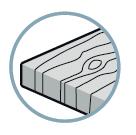






n Applications for airtight products (p.12)
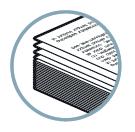





n Applications for porous products (p.14)









In the case of gripping airtight products, a high vacuum level is required to increase the gripping force of the suction cups. è Vacuum generator with a vacuum of 88% should be considered. Therefore, the suction flow should be the criteria used to reduce evacuation time.

Main criteria: evacuation time
In this case, it's the only factor to be considered. è It is inversely proportional to the consumption.
The evacuation time is increasing exponentially with the vacuum level This can be explained by the rarefaction of the air during evacuation
For airtight products, it is recommended to use vacuum pumps with ASC (Air Saving Control) technology, which can save up to 99% of compressed air. ASC (Air Saving Control) technology, which allows up to 99% savings in compressed air.


For airtight or semi-airtight products, the vacuum pumps with ASC automatically run the above “ASC” cycle, thus resulting in maximum energy savings, according to the following three phases:


1 - Object is gripped: vacuum generated by the Venturi pump.
2 - Operations on object held in place by vacuum: at the L2 vacuum threshold (75%), the supply of the Venturi pump is cut off è the consumption becomes zero; the object remains held in place due to the non-return valve. If micro-leaks make the vacuum drop to threshold L2 less the defined hysteresis value, vacuum generation is briefly switched on again.
è 90%
AUTO-ADJUSTMENT: At each cycle, the ASC analyzes the level of leakage and adapts itself. Example: In the case of flexible production requiring the handling of porous products, the ASC detects the leaks, and immediately adapts the vacuum pump operation terminating the cycle without vacuum regulation.
3 - Object is released: by an external or an automatic timed blow-off command (according to the settings).

on airtight or semi-airtight products of compressed air saving on average.
Calculate the savings you can generate with our ASC technology using our ENERGY SAVING APP available online. ENERGY



2. Gripping for porous products
Choice of vacuum generator
The most penalising parameter is the leakage rate due to the porosity of the handling products. In this case, it is compulsory to choose a vacuum generator able to supply enough flow rate (at the required vacuum level) to compensate the leakage due to the porosity of the product.
Practical test is always better than theoretical study and it can be done using a master venturi which will be used to quantify the leakage rate through the product.
Procedure for performing a porosity test (opposite page).
Main criteria:
- Vacuum threshold necessary for the gripping
è The higher it will be, the more powerful the vacuum generator should be
- Porosity of the application


è It is necessary to make a porosity test to evaluate the leakage per cup.
Required vacuum threshold :
It possible to use the «cross product» method to determine the force at different vacuum levels
F2 = F1xV2/V1 (F = force, V = Vacuum level)
ex : F1= 20N at 65% vacuum, calculater F2 with 40% vacuum.
Example with the characteristics chart of the 1.5 bellows vacuum cups, series VSA. Available in the general catalog
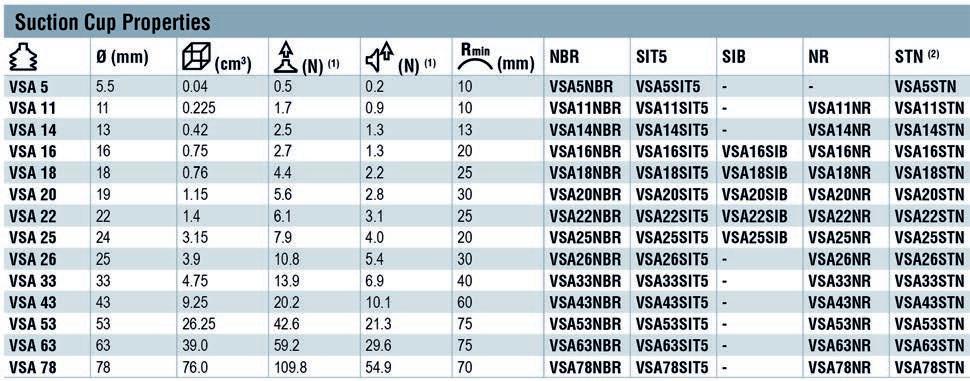


Procedure for performing a porosity test using the VR07TEST

è Step 1:
- Connect a pressure of 6 bars to the venturi (represented by letter P)
- Connect the selected suction cup (represented by letter V)
è Step 2:
- Check that your assembly is per fectly tight by testing the suction cup on a smooth and flat surface. The target vacuum value should be between 85 and 88% vacuum.

è Step 3:

- Test the surface of your product to be handled and note the vacuum value obtained. In order to have a reliable and accurate result, please test several areas of your product.



Application: Horizontal gripping of a 12kg cardboard box.
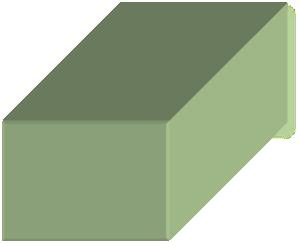
• Choice of suction cups, VSA series, because they combine the advantages of flat suction cups (strength), with more stroke (1.5 bellows)
• Number of suction cups: 6 to distribute the efforts and not to deform the cardboard

• Choice of Ø Suction cups:

12kg load capacity
Number of suction cups = 2kg (see of characteristics chart of VSA series suction cups

2kg at 65% vacuum) è VSA43 (Ø 43mm)
Measure the leakage rate with only one selected suction cup (e.g. VSA43NR) and the Venturi Test VR07TEST (available in the VACUOKIT case) at a supply pressure pressure of 5 bar (The VR07TEST is a In-line Ejector equipped with an electronic Vacuostat with display allowing a quick reading of the vacuum level obtained).
Once the porosity test has been performed, transfer the vacuum level obtained on the Suction flow rate/vacuum curves: of the VR07 on the catalog (see curve opposite) the vacuum level obtained on your sample, this will indicate the leakage rate

In this case, the leakage rate is 7.5Nl/min for one suction cup, that is 6*7.5=45Nl/min for the 6 suction cups needed.
Find the suitable vacuum pump based on the minimum suction flow rate to compensate leaks and the required vacuum level.
Reminder:
• Leakage rate to compensate: 45Nl/min
• Minimum vacuum for the force required for the 6 suction cups: 65%
Once you have selected the range of vacuum pumps according to the desired functions, enter the vacuum level and the desired suction flow rate on the Flow/Vacuum curves and mark the curve crossing your points

Thus, you determine the vacuum generator with a sufficient suction flow to compensate the porosity of the material and to obtain a vacuum level of 65% allowing the suction cups to guarantee the gripping of the cardbox
Result: LEM90X25
The vacuum network architecture must respect essential rules to ensure optimal performance.
Symmetrical repartition
Suction cup positioning as close as possible to the vacuum generator
Avoid 90° bends and restrictions
Limit the tube length
Consistancy in the choice of tube diameters according to the below sizing chart
Extend the network keeping the section of the initial tube
Ex: 1 tube Ø12 (113 mm²) is divided into 4 tubes Ø6 (113 mm²)
Reminder: S=πR²

To respect a remaining vacuum of maxi 10% (suction cups not in gripping position)
Flow (Nl/min)
Tube diameters (mm)

The use of a multitude of T-fittings, and and the use of the same Ø of Tube from the power supply of the to the suction cups creates important pressure losses and does not allow to diffuse the vacuum and blowoff for release in optimal conditions.



The use of a larger tube diameter to ensure the supply of the gripper and a central distribution manifold makes the gripper's behaviour much more homogeneous by limiting the pressure losses.
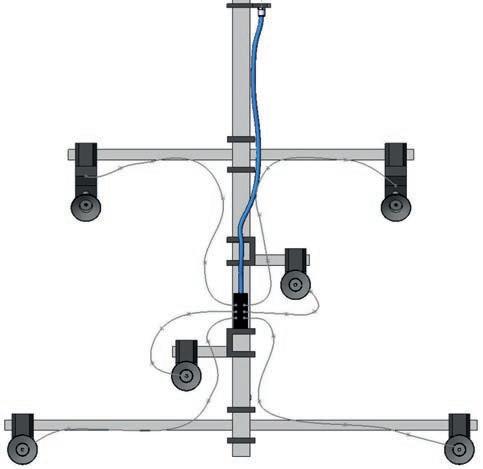
Advantages:
• Reduced evacuation time


• Reduced of the release time
• Homogeneity of the behaviour of the suction cups and release


Flow (Nl/min)
Integrate the maximum consumed flow rate once all the machine's components work in the same time.
Air quality according ISO 8573-1 Class 4 standard (filtration 5µ). Dry air, non lubricated. If necessary, use filters, oil and water separators before the vacuum generator.
Check that the compressor is correctly dimensioned according to the simplified formula:

10Nm3/h of pneumatic consumption
1kW of power required by the compressor
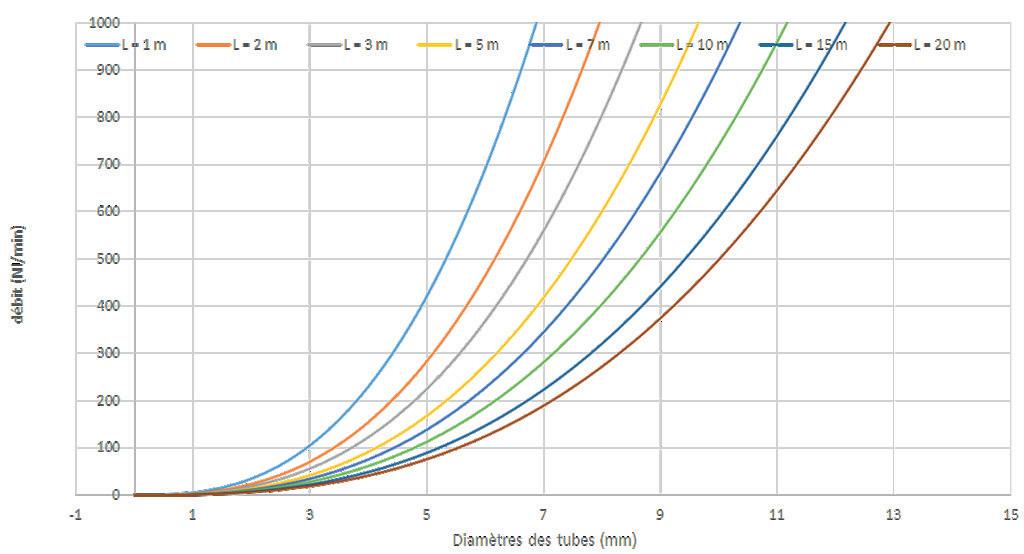
To respect a ΔP of maxi 0,5 b with input pressure of 5,5b
Tube diameters (mm)
The 5 steps to respect for optimal performance
1 2 3 4 5
Defining the forces and constraints of the application
Determining the suitable suction cups
Determining the suitable vacuum generator Selecting accessories Network architecture
Checklist of the technical specifications to consider



Impossible to reach the vacuum threshold
è Check the quality of the vacuum network (airtight fittings and state of the suction cups)
è Check the supply pressure
è Check if the vacuum generator is correctly dimensioned to compensate porosity leakages
No signal from the vacuum switch
è Check the vacuum threshold settings
Impossible to activate the vacuum or the blow-off
è Check the wiring and the LEDs state
è Check power supply
The vacuum regulation is frequently activated
è Leakage on the vacuum network. You need to check each connection starting from the cups to vacuum generator blocking one after another

